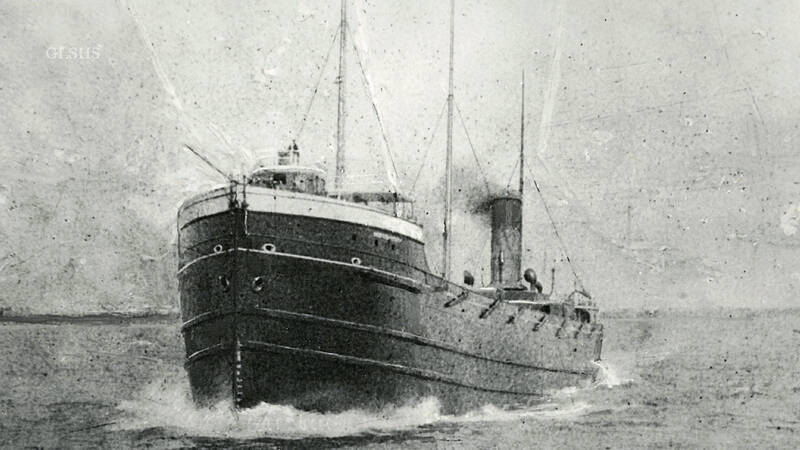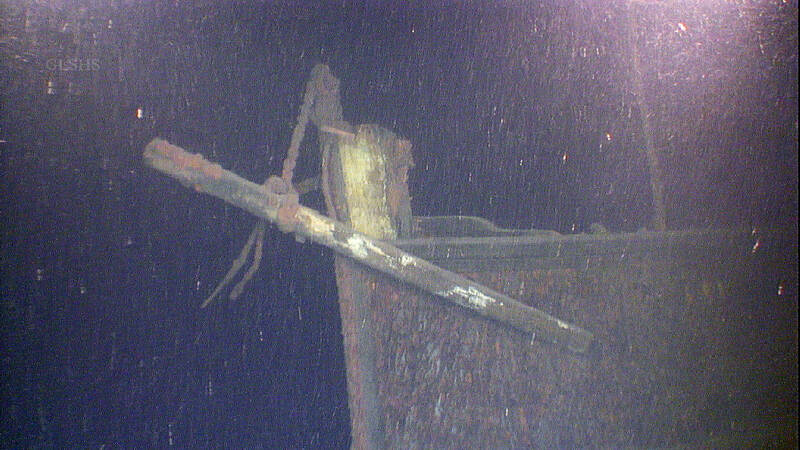Twenty years before the Titanic changed maritime history, another ship touted as the next great technological feat set sail on the Great Lakes.
The Western Reserve was one of the first all-steel cargo ships to traverse the lakes. Built to break speed records, the 91.4-meter freighter dubbed “the inland greyhound” by newspapers was supposed to be one of the safest ships afloat. Owner Peter Minch was so proud of her that he brought his wife and young children aboard for a summer joyride in August 1892.
As the ship entered Lake Superior’s Whitefish Bay between Michigan and Canada on Aug. 30, a gale came up. With no cargo aboard, the ship was floating high in the water. The storm battered it until it cracked in half. Twenty-seven people perished, including the Minch family. The only survivor was wheelsman Harry W. Stewart, who swam 1.6 kilometers to shore after his lifeboat capsized.

Photo: AP
For almost 132 years the lake hid the wreckage. In July, explorers from the Great Lakes Shipwreck Historical Society pinpointed the Western Reserve off Michigan’s Upper Peninsula. The society announced the discovery Saturday at the annual Ghost Ships Festival in Manitowoc, Wisconsin.
“There’s a number of concurrent stories that make this important,” the society’s executive director, Bruce Lynn, said in a telephone interview. “Most ships were still wooden. It was a technologically advanced ship. They were kind of a famous family at the time. You have this new ship, considered one of the safest on the lake, new tech, a big, big ship. (The discovery) is another way for us to keep this history alive.”
TWO-YEAR SEARCH

Photo: AP
Darryl Ertel, the society’s marine operations director, and his brother, Dan Ertel, spent more than two years looking for the Western Reserve. On July 22 they set out on the David Boyd, the society’s research vessel. Heavy ship traffic that day forced them to alter their course, though, and search an area adjacent to their original search grid, Lynn said.
The brothers towed a side-scanning sonar array behind their ship. Side sonar scans starboard and port, providing a more expansive picture of the bottom than sonar mounted beneath a ship. About 97 kilometers northwest of Whitefish Point on the Upper Peninsula, they picked up a line with a shadow behind it in 182 meters of water. They dialed up the resolution and spotted a large ship broken in two with the bow resting on the stern.
CONFIRMATION DAY
Eight days later, the brothers returned to the site along with Lynn and other researchers. They deployed a submersible drone that returned clear images of a portside running light that matched a Western Reserve’s starboard running light that had washed ashore in Canada after the ship went down. That light was the only artifact recovered from the ship.
“That was confirmation day,” said Lynn, the society’s executive director.
Darryl Ertel said that discovery gave him chills — and not in a good way. “Knowing how the 300-foot Western Reserve was caught in a storm this far from shore made a uneasy feeling in the back of my neck,” he said in a society news release. “A squall can come up unexpectedly…anywhere, and anytime.”
Lynn said that the ship was “pretty torn up” but the wreckage appeared well-preserved in the frigid fresh water.
DANGEROUS GREAT LAKES
The Great Lakes have claimed thousands of ships since the 1700s. Perhaps the most famous is the Edmund Fitzgerald, an ore carrier that got caught in a storm in November 1975 and went down off Whitefish Point within 100 miles of the Western Reserve. All hands were killed. The incident was immortalized in the Gordon Lightfoot song, “The Wreck of the Edmund Fitzgerald.”Assistant Wisconsin State Climatologist Ed Hopkins said that storm season on the lakes begins in November, when warm water meets cold air and winds blow unimpeded across open water, generating waves as high as 9.1 meters. The lakes at that time can be more dangerous than the oceans because they’re smaller, making it harder for ships to out-maneuver the storms, he said.
Brittle steel may have played a role in sinking
But it’s rare to see such gales form in August, Hopkins said. A National Weather Service report called the storm that sank the Western Reserve a “relatively minor gale,” he noted.
A Wisconsin Marine Historical Society summary of the Western Reserve sinking noted that the maritime steel age had just begun and the Western Reserve’s hull might have been weak and couldn’t handle the bending and twisting in the storm. The steel also becomes brittle in low temperatures like those of Great Lakes waters. The average water temperature in Lake Superior in late August is about 16 degrees Celsius, according to the National Oceanic and Atmospheric Administration.
The summary notes the Titanic used the same type of steel as the Western Reserve and that it may have played a role in speeding up the luxury liner’s sinking.

April 14 to April 20 In March 1947, Sising Katadrepan urged the government to drop the “high mountain people” (高山族) designation for Indigenous Taiwanese and refer to them as “Taiwan people” (台灣族). He considered the term derogatory, arguing that it made them sound like animals. The Taiwan Provincial Government agreed to stop using the term, stating that Indigenous Taiwanese suffered all sorts of discrimination and oppression under the Japanese and were forced to live in the mountains as outsiders to society. Now, under the new regime, they would be seen as equals, thus they should be henceforth

Last week, the the National Immigration Agency (NIA) told the legislature that more than 10,000 naturalized Taiwanese citizens from the People’s Republic of China (PRC) risked having their citizenship revoked if they failed to provide proof that they had renounced their Chinese household registration within the next three months. Renunciation is required under the Act Governing Relations Between the People of the Taiwan Area and the Mainland Area (臺灣地區與大陸地區人民關係條例), as amended in 2004, though it was only a legal requirement after 2000. Prior to that, it had been only an administrative requirement since the Nationality Act (國籍法) was established in

With over 80 works on display, this is Louise Bourgeois’ first solo show in Taiwan. Visitors are invited to traverse her world of love and hate, vengeance and acceptance, trauma and reconciliation. Dominating the entrance, the nine-foot-tall Crouching Spider (2003) greets visitors. The creature looms behind the glass facade, symbolic protector and gatekeeper to the intimate journey ahead. Bourgeois, best known for her giant spider sculptures, is one of the most influential artist of the twentieth century. Blending vulnerability and defiance through themes of sexuality, trauma and identity, her work reshaped the landscape of contemporary art with fearless honesty. “People are influenced by

Three big changes have transformed the landscape of Taiwan’s local patronage factions: Increasing Democratic Progressive Party (DPP) involvement, rising new factions and the Chinese Nationalist Party’s (KMT) significantly weakened control. GREEN FACTIONS It is said that “south of the Zhuoshui River (濁水溪), there is no blue-green divide,” meaning that from Yunlin County south there is no difference between KMT and DPP politicians. This is not always true, but there is more than a grain of truth to it. Traditionally, DPP factions are viewed as national entities, with their primary function to secure plum positions in the party and government. This is not unusual